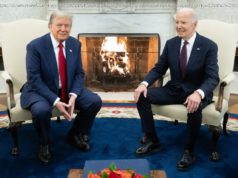Q&A: What does the US military do on Guam, a small island and U. S. territory in the Pacific?.
The small U. S. territory of Guam has become a focal point after North Korea’s army threatened to use ballistic missiles to create an „enveloping fire“ around the island. The exclamation came after President Donald Trump warned Pyongyang of „fire and fury like the world has never seen.“ Here’s a look at the U. S. military’s role on the island, which became a U. S. territory in 1898.
___
WHAT INSTALLATIONS ARE ON GUAM AND HOW SIGNIFICANT ARE THEY?
There are two major bases on Guam: Andersen Air Force Base in the north and Naval Base Guam in the south. They are both managed under Joint Base Marianas. The tourist district of Tumon, home to many of Guam’s hotels and resorts, is in between.
The naval base dates to 1898, when the U. S. took over Guam from Spain after the Spanish-American War. The air base was built in 1944, when the U. S. was preparing to send bombers to Japan during World War II.
Today, Naval Base Guam is the home port for four nuclear-powered fast attack submarines and two submarine tenders.
Andersen Air Force Base hosts a Navy helicopter squadron and Air Force bombers that rotate to Guam from the U. S. mainland. It has two 2-mile long runways and large fuel and munitions storage facilities.
Altogether, 7,000 U. S. military personnel are stationed on Guam. Most are sailors and airmen. The military plans to move thousands of U. S. Marines to Guam from Okinawa in southern Japan.
Guam’s total population is 160,000.
___
WHAT ROLES DO THE BASES PLAY IN THE REGION
Guam is strategically located a short flight from the Korean peninsula and other potential flashpoints in East Asia. Seoul is 2,000 miles to the northwest, Tokyo is 1,500 miles north and Taipei is 1,700 miles west.
Because Guam is a U. S. territory, the U. S. military may launch forces from there without worrying about upsetting a host nation that may object to U. S. actions.
The naval base is an important outpost for U. S. fast-attack submarines that are a key means for gathering intelligence in the region, including the Korean peninsula and the South China Sea where China has been building military bases on man-made islands.
___
HOW HAS THE U. S. USED GUAM TO ADDRESS THE THREAT FROM NORTH KOREA?
The U. S. military began rotating bombers — the B-2 stealth bomber as well as the B-1 and B-52 — to Andersen in 2004. It did so to compensate for U. S. forces diverted from other bases in the Asia-Pacific region to fight in the Middle East. The rotations also came as North Korea increasingly upped the ante in the standoff over its development of nuclear weapons.
In 2013, the Army sent a missile defense system to Guam called Terminal High Altitude Area Defense or THAAD.
It’s designed to destroy ballistic missiles during their final phase of flight. A THAAD battery includes a truck-mounted launcher, tracking radar, interceptor missiles and an integrated fire control system.
___
WHAT’S THE HISTORY OF THE U. S. MILITARY ON GUAM?
The U. S. took control of Guam in 1898, when Spanish authorities surrendered to the U. S. Navy. President William McKinley ordered Guam to be ruled by the U. S. Navy. The Navy used the island as a coaling base and communications station until Japan seized the island on Dec. 10,1941. The U. S. took back control of Guam on July 21,1944.
During the Vietnam War, the Air Force sent 155 B-52 bombers to Andersen to hit targets in Southeast Asia. Guam was also a refueling and transfer spot for military personnel heading to Southeast Asia. Many refugees fleeing Vietnam were evacuated through Guam.
Sign up today for a free 30 day free trial of unlimited digital access.






